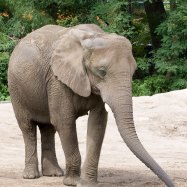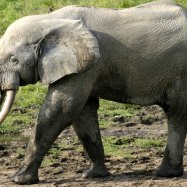
Gigantopithecus
10 to 12 feet
Gigantopithecus is an extinct giant ape that roamed Southeast Asia over 100,000 years ago. At 10 to 12 feet long, it was the largest primate to ever exist. Belonging to the Hominidae family, its massive and robust body shape is a testament to its strength. Fossil remains continue to intrigue scientists about this mysterious creature. #Gigantopithecus #extinctape #SoutheastAsia
Animal Details Summary:
Common Name: Gigantopithecus
Kingdom: Animalia
Habitat: Tropical and subtropical rainforests
The Elusive Giant of the Rainforests: Gigantopithecus
The lush tropical and subtropical rainforests of Asia are home to an abundance of wildlife, from the smallest insects to the largest mammals. But there was once a creature that ruled these forests, a true giant among primates. Its scientific name is Gigantopithecus, and it is believed to be the largest primate that ever roamed the Earth. In this article, we will delve into the fascinating world of this mysterious and extinct species, exploring its physical characteristics, habitat, and the theories surrounding its extinction Gigantopithecus.A Classification of Gigantopithecus
Gigantopithecus belongs to the animal kingdom, as all living organisms do. Within the kingdom, it falls under the phylum Chordata, indicating its possession of a spinal cord. The class Mammalia places it among other mammals, characterized by their warm-bloodedness, hair, and mammary glands for nursing their young. Moving further along the taxonomic hierarchy, we come to the order Primates, which includes all primates, such as monkeys, apes, and humans. Gigantopithecus belongs to the same family as humans, the Hominidae family, and is closely related to the orangutans, gorillas, and chimpanzees.A Habitat Fit for a Giant
The name Gigantopithecus means "giant ape" in Latin, and it is not hard to see why it was given such a name. This primate was massive, and its size is comparable to that of a modern-day gorilla. It is estimated to have been around 10 to 12 feet tall, and could weigh up to a whopping 1,100 pounds. To put that into perspective, the average human male is around 5'9'' and weighs approximately 180 pounds Green Sunfish. Just imagining a primate twice the size of a human is mind-boggling.Gigantopithecus roamed the rainforests of Asia, specifically in China, India, and Vietnam. Fossil remains of this species have been found in these countries, indicating that it had a widespread distribution. Its preferred habitat was the tropical and subtropical rainforests, with their thick vegetation and ample food supply. The rainforests of Asia are known for their high biodiversity, making them the ideal home for Gigantopithecus.
An Herbivore with a Massive Appetite
Gigantopithecus was a herbivorous primate, meaning it fed on plants and plant-based foods. With its size and weight, it is not surprising that this species required a massive amount of food to sustain itself. Its dental and jaw structure point to a diet primarily consisting of tough, fibrous plant material. It is believed that they fed on a variety of plants such as leaves, fruits, and roots, making use of their strong jaws and teeth to break down and chew their food.Some researchers have suggested that the diet of Gigantopithecus may have also included bamboo. This theory is based on the discovery of bamboo fossils at the same sites where Gigantopithecus fossils were found. The giant ape's massive bulk required a high-calorie diet, and bamboo is known for its high caloric content.
Uncovering the Mystery of Gigantopithecus
Despite its massive size, very little is known about Gigantopithecus. Due to its extinction, researchers have had to rely on fossil evidence to piece together information about this species. Unfortunately, these fossil remains are limited, making it challenging to gain a complete understanding of this giant ape.One of the biggest mysteries surrounding Gigantopithecus is its appearance. With no living specimens, scientists can only rely on the structure and shape of its bones to make assumptions about its physical appearance. Its body shape is believed to have been large and robust, similar to that of a gorilla. However, unlike gorillas, Gigantopithecus had a relatively shorter torso and longer arms.
Although its size is impressive, researchers are uncertain about the coloration of Gigantopithecus. Without any pigmentation preserved in the fossilized remains, it is impossible to determine what color this species may have been. Some theories suggest that it may have been dark-colored to blend in with its rainforest habitat, while others propose that it had a lighter, reddish-brown color like orangutans.
Disappearance from the Earth
If Gigantopithecus was such a dominant and colossal species, what led to its disappearance from the planet? There are several theories surrounding the extinction of this giant ape, but the exact cause remains a mystery. The most accepted theory is that of climate change.During the Pleistocene epoch, which lasted from approximately 2.6 million years ago to 11,700 years ago, the Earth went through periods of intense climate fluctuations. Large-scale glaciation occurred, followed by warmer periods, leading to the disappearance of many species, including Gigantopithecus. It is believed that this species may have been sensitive to these shifts in climate, and the loss of their preferred habitat and food sources led to their eventual extinction.
Another theory proposes that competition with other primates, such as orangutans and humans, may have also played a role in the decline and eventual extinction of Gigantopithecus. With the gradual expansion of humans into their territory and the orangutan's dominance in the rainforests, Gigantopithecus may have been pushed to the brink of extinction.
The Legacy of Gigantopithecus
Even though Gigantopithecus may have vanished from the Earth, its impact and legacy continue to intrigue and fascinate us. Its massive size and mysterious extinction have captured the imagination of researchers and the general public for decades. Palaeontologists continue to search for new fossil remains and analyze existing ones to uncover more information about this elusive species.Gigantopithecus has also inspired many works of literature and films, such as the iconic King Kong and Tarzan. Its reputation as a fearsome and mighty creature has been etched into popular culture, cementing its place in history as the largest primate that ever lived.
Conclusion
In conclusion, Gigantopithecus was a remarkable and enigmatic species that roamed the rainforests of Asia millions of years ago. Its size, diet, and habitat have led researchers to believe that it played a significant role in the ecosystem of its time. It is a reminder of the diversity and wonders of our planet, and its extinction serves as a cautionary tale of the effects of climate change on our environment. While we may never fully understand the mystery of Gigantopithecus, its legacy continues to live on, captivating our imaginations and inspiring us to learn more about the world we live in.
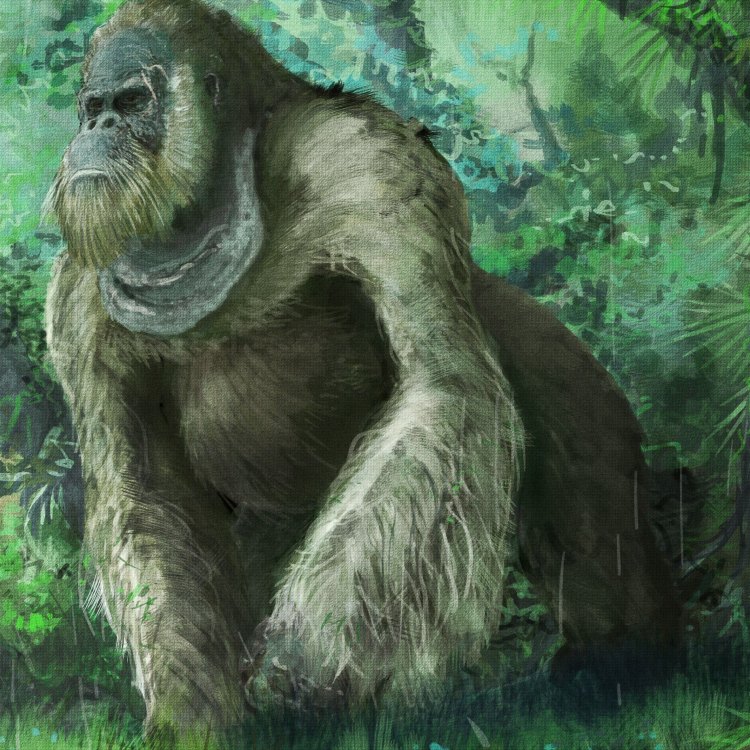
Gigantopithecus
Animal Details Gigantopithecus - Scientific Name: Gigantopithecus
- Category: Animals G
- Scientific Name: Gigantopithecus
- Common Name: Gigantopithecus
- Kingdom: Animalia
- Phylum: Chordata
- Class: Mammalia
- Order: Primates
- Family: Hominidae
- Habitat: Tropical and subtropical rainforests
- Feeding Method: Herbivorous
- Geographical Distribution: Asia
- Country of Origin: China, India, Vietnam
- Location: Fossil remains found in Southeast Asia
- Animal Coloration: Unknown
- Body Shape: Large and robust
- Length: 10 to 12 feet
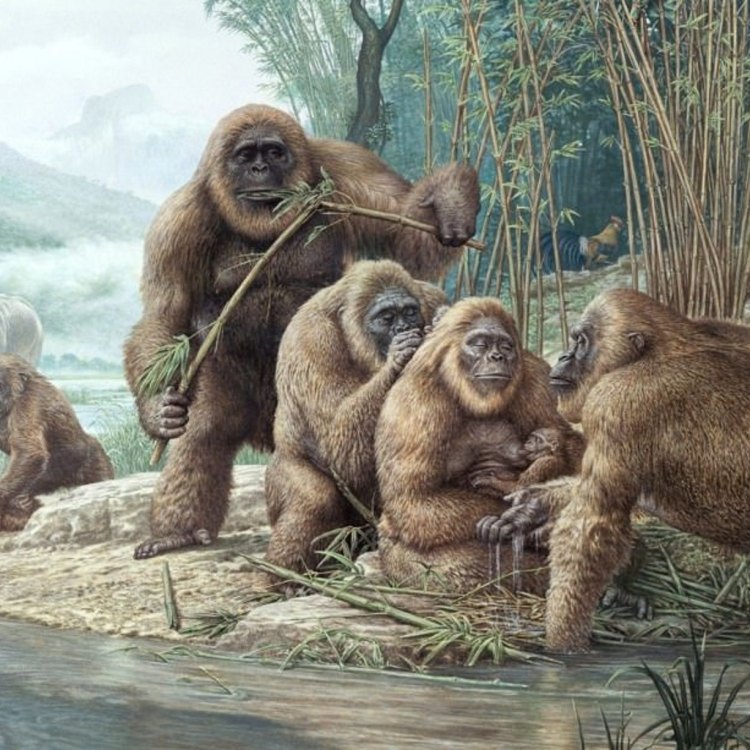
Gigantopithecus
- Adult Size: Up to 10 feet tall
- Average Lifespan: Estimated to be around 35 years
- Reproduction: Unknown
- Reproductive Behavior: Unknown
- Sound or Call: Unknown
- Migration Pattern: Unknown
- Social Groups: Unknown
- Behavior: Unknown
- Threats: Extinction, loss of habitat
- Conservation Status: Extinct
- Impact on Ecosystem: Unknown
- Human Use: None
- Distinctive Features: Large size, robust build
- Interesting Facts: Gigantopithecus is the largest known primate to have ever lived.
- Predator: Unknown
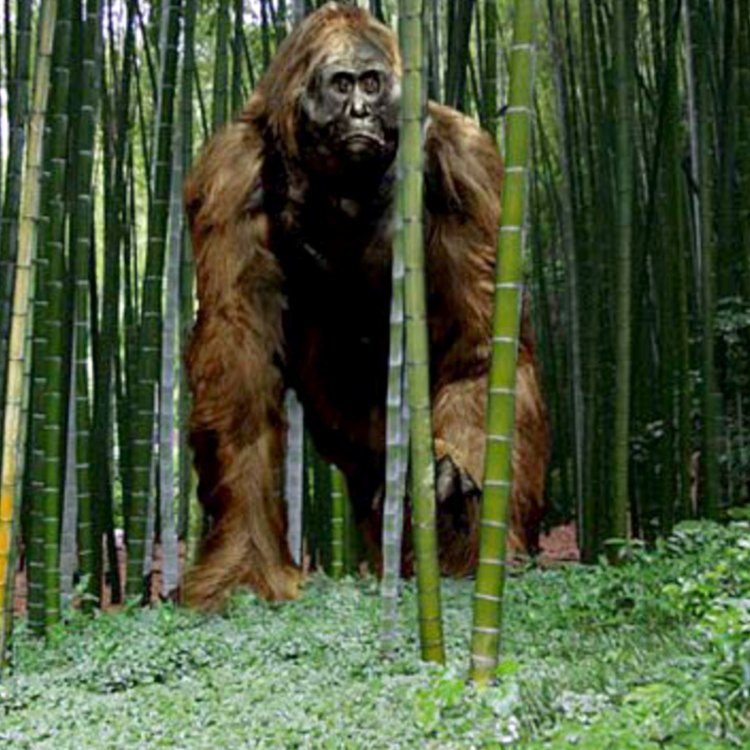
Gigantopithecus
The Enigmatic Giant: Exploring the World of Gigantopithecus
In the world of primates, there have been many remarkable and fascinating species. From the agile and intelligent chimpanzees to the gentle and elusive gorillas, these creatures have captured the attention and curiosity of humans for centuries. However, there is one primate that stands out from the rest due to its sheer size and enigmatic nature - the Gigantopithecus.With an adult size of up to 10 feet tall, the Gigantopithecus is the largest known primate to have ever existed PeaceOfAnimals.Com. Yet, despite its colossal size, very little is known about this mysterious creature. In this article, we will dive into the world of Gigantopithecus, exploring its features, behavior, and impact on the ecosystem.
The Basics: Adult Size and Average Lifespan
Gigantopithecus is estimated to have roamed the earth during the Pleistocene epoch, approximately 9 million to 100,000 years ago. Fossils of this behemoth primate have been found in various parts of Asia, including China, Vietnam, and India.One of the most striking features of Gigantopithecus is its size. It is believed to have stood at an impressive height of 10 feet and could weigh up to 1,200 pounds. To put that into perspective, a male silverback gorilla, which is known to be the largest living primate, stands at an average height of 6 feet and weighs around 500 pounds. This makes Gigantopithecus almost twice the size of a gorilla, making it a true giant among primates.
As for its lifespan, researchers can only estimate based on the life expectancy of living primates Gray Tree Frog. It is believed that Gigantopithecus had an average lifespan of around 35 years, similar to modern-day gorillas.
Mysterious Reproductive Behavior and Social Groups
One of the biggest mysteries surrounding Gigantopithecus is its reproductive behavior. Due to the scarcity of fossils, very little is known about how these creatures bred or raised their young. Researchers have not been able to find any fossil evidence of Gigantopithecus infants or juveniles, making it challenging to understand their reproductive behavior.Similarly, there is no information about their social groups or behavior. Unlike other primates, such as chimpanzees and gorillas, who live in cohesive social groups, we are not sure if Gigantopithecus had a similar social structure. It is possible that due to their large size, these primates were solitary, but there is no way to confirm this without further evidence.
The Unknown Sound or Call of Gigantopithecus
Another aspect that remains a mystery is the vocalization or communication of Gigantopithecus. It is unknown if these creatures made any sounds or calls to communicate with each other. Since they lived in dense forests and their fossils have been found in areas with high rainfall, it is possible that their communication was limited to close-range interactions. However, without any evidence, it is challenging to determine how they communicated.Elusive Migration Pattern and Unexplained Behavior
The migration pattern of Gigantopithecus is another enigma that researchers are trying to unravel. Some theories suggest that they were nomadic, while others believe they were sedentary and stayed in one area throughout their lives. Without any fossil evidence, it is impossible to determine their movement patterns and why they traveled, if at all.Similarly, their behavior is also largely unknown. It is assumed that due to their massive size, they were herbivores and fed on bamboo, fruits, and other plant matter. However, whether they were aggressive or docile, their mating rituals, and other behavior remains a mystery.
The Threat of Extinction and Conservation Status
Despite their massive size and strength, Gigantopithecus could not withstand the ever-changing world. It is believed that the combination of various factors, including climate change, loss of habitat, and competition with other species, led to their extinction.These primates lived during a time when the world was undergoing significant climatic changes, and their habitats were greatly affected. As a result, they were forced to compete for resources with other animals, and perhaps they lost this battle. Today, some experts also believe that the arrival of ancient humans, with their superior hunting skills, could have contributed to the decline of Gigantopithecus.
Unfortunately, due to their extinction thousands of years ago, there is no way to study these creatures and understand their exact cause of extinction. Today, Gigantopithecus is listed as extinct on the International Union for Conservation of Nature (IUCN) Red List.
The Impact on Ecosystem and Human Use
The loss of any species can have a significant impact on the ecosystem, and the extinction of Gigantopithecus was no exception. As a large herbivore, they played a crucial role in maintaining the balance of their environment by helping to disperse seeds, control plant growth, and provide a source of food for other animals.Their extinction resulted in a void in the ecosystem, and it is possible that it had ripple effects on other species and their survival. Unfortunately, there is also evidence to suggest that humans hunted and used Gigantopithecus for various purposes, including food, tools, and medicine. However, there is not enough evidence to confirm this, and it does not seem that humans had a significant impact on their extinction.
Distinctive Features and Interesting Facts
The most distinctive feature of Gigantopithecus is undoubtedly its size and robust build. Standing at 10 feet tall and weighing over 1,000 pounds, these creatures were true giants of the primate world. They had a wide jaw and strong teeth, indicating that they had a powerful bite that could crush through tough vegetation.Despite being one of the largest primates, they had relatively small brains compared to other monkeys and apes, suggesting that they were not as intelligent. However, their large size may have been an evolutionary advantage in their environment, allowing them to gather and consume more food, and possibly, compete for mates.
Aside from their distinctive features, Gigantopithecus has also provided us with some fascinating discoveries. In 1935, a German paleoanthropologist, Gustav Heinrich Ralph von Koenigswald, first identified Gigantopithecus based on a few teeth and a jawbone found in China. Over the years, more fossils have been discovered, including pieces of skulls and teeth. Studies of these fossils have helped reconstruct the anatomy of this enigmatic primate, giving us a glimpse into its world.
The Predators of Gigantopithecus
It is impossible to talk about the Gigantopithecus without mentioning its predators, even though very little is known about them. Due to their size and strength, it is believed that Gigantopithecus did not have any natural predators. However, they may have faced some competition from other large predators, such as saber-toothed cats and ancient bears.The Legacy of Gigantopithecus
Despite its extinction, Gigantopithecus continues to fascinate and intrigue scientists and the general public alike. Its massive size, combined with the mystery surrounding its behavior and lifestyle, has earned it a special place in the world of primates. Today, researchers continue to study this enigmatic creature, hoping to uncover more clues and learn about its role in the evolution of primates.In conclusion, Gigantopithecus remains a mysterious and fascinating species, shrouded in many unanswered questions. From its colossal size and distinctive features to its unknown behavior and enigmatic lifestyle, this giant primate continues to captivate our imagination. While we may never fully understand the world of Gigantopithecus, it remains an essential part of our prehistoric past and a reminder of the diversity and wonder of the animal kingdom.

The Elusive Giant of the Rainforests: Gigantopithecus
Disclaimer: The content provided is for informational purposes only. We cannot guarantee the accuracy of the information on this page 100%. All information provided here may change without prior notice.







